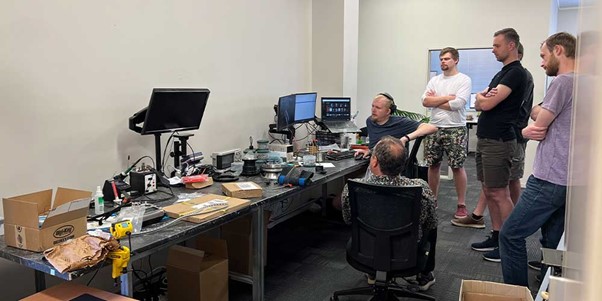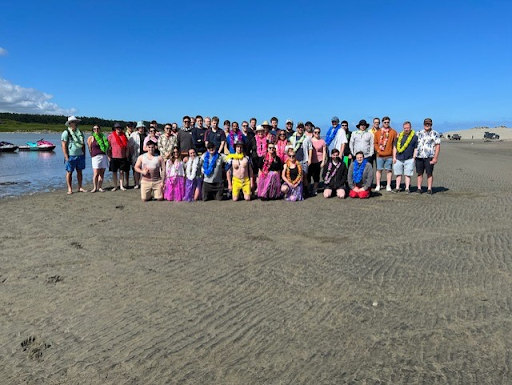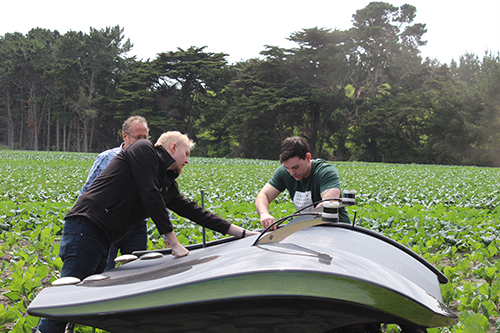“I started with nothing. I didn’t have money to buy good tools or good equipment and so I had to make do with rubbish. I had to make something out of nothing. Now I use top end German motors and stainless steel, injection moulded components. My goal was always to build the highest quality machine I could. I wanted to build the best in the world.”
“Like many Kiwis in Agritech, I grew up on a farm,” says Don Sandbrook, CEO of Greentech Robotics. “There’s a real practical value that comes from being able to jump on a tractor and work with soil, plants, and people. That grounding gives you a great head start.”
“I’ve dealt a lot with companies in America and Europe and very few Agritech entrepreneurs grow up with that multiskilled, small-farm experience you get in New Zealand. One day you’re baling hay, the next you’re cultivating a paddock or planting a maize crop. You get a lot of variety and that experience is a big advantage in this industry.”
Sandbrook has had more varied work experiences than most. He left school at 15 and worked in 36 different jobs before setting up his own business. One of his first jobs was with an engineering shop where he did a fitting and turning apprenticeship that sparked his interest in electronics and inventing things.
“I’m a bit weird,” he says. “I can visualise a machine in my mind and build it. I’ve always been able to do that.”
While working as a technician at Massey University, Sandbrook worked on a direct drill seeding system he describes as ‘a heap of junk’.
“It was designed by academics with no practical sense of what problem it was designed to solve,” he says. “A lot of government money went into developing it but nobody stepped back and said, ‘Hang on a minute. This has no practical application. It’s a stupid piece of machinery.’ I could see a way to make it simpler and more effective but nobody would listen to me because I was just a technician.”
Determined to prove he could build something better, Sandbrook spent weekends and late nights puttering around in his garage trying to invent an accurate, automated seed dispensing system.
“I spent well over a thousand hours trying and failing to make something that worked the way I wanted it to,” he says. “Then, one morning I got up, put my boots on, walked 10 metres to the garage and on the way I saw this machine in my head as clear as day. I thought, ‘that’s what I’m going to build.’”
Like many entrepreneurs, Sandbrook thought coming up with the idea was the hard part but when he tried to sell his invention to Kiwi dairy farmers it turned out they didn’t need a seeding system to grow good grass. Nobody was interested until a representative for Watties saw Sandbrook’s system at Fieldays and asked if it could sow carrot seed.
The challenges of going global

Sandbrook modified his machine to cater for carrot seed and Watties planted 40 acres using the first iteration of the SeedSpider. Sandbrook drove down to Canterbury to see the results.
“I remember it was just before sunset and I walked into this field and saw this beautiful, perfectly-spaced, weed-free crop of baby carrots. I cried my eyes out. I’d always wanted to work for myself and I knew the SeedSpider would help me put food on the table for my family.”
Watties introduced Sandbrook to one of the UK’s leading suppliers of fresh produce and salad greens and that led to relationships with distributors and growers all over Europe. The US was a tougher nut to crack.
“Every time I went to Europe I flew home through the US to see a distributor. I’d show them the SeedSpider and photographs of crops planted in England using the system. ‘This is not goddamn England,’ they’d say to me. ‘Show us some crops in America planted using the SeedSpider.’”
“It was a chicken and egg situation. I desperately needed someone in the US to give me a break and I finally convinced a distributor to trial our system at a trade show in Las Vegas. I literally had to chase after him and drag him back to my stand to show him what it could do. My big break was down to sheer bloody-minded persistence.”
The company did a 2,000 acre trial which resulted in a 10 percent increase in yield compared to their existing seeding system. Today up to 80 percent* of salad and baby carrot crops in the US are planted using the SeedSpider and Sandbrook is convinced that ‘sheer bloody minded persistence’ is still the key to building a global business.
“I’m not frightened to knock on the door of a CEO or an agronomist or jump on a tractor and demo some equipment,” he says. “I’m happy to get dirt under my fingernails and talk to the workers in the field to get their opinion on the problems they face every day. I have no fear of dealing with people up and down the business.”
Greentech Robotics mission is a bold one: to future-proof farming by developing cutting-edge robotic capability across the agricultural and horticultural sector. The company is set to launch the WeedSpider in the US in late 2022, a fully autonomous robotic weeder which aims to quickly and accurately remove weeds from commercial vegetable fields.
The technology aims to address a substantial pain point for growers, namely labour cost and supply. Research shows 55 percent of farms in the U.S are experiencing severe labour shortages. On top of this, due to population growth, demand for food is set to increase by 70 percent in the next 30 years. The WeedSpider won’t replace migrant workers but it will boost productivity and increase yields.
“Don is a really sound, strategic thinker and he’s got a great ability to see where there is a need or gap in the market and come up with a solution,” says David Fountain of the Solex Corporation, a leading distributor of horticulture and agriculture equipment in the US. “He’s fearless when it comes to investing time, money and resources into designing and delivering a new product to the market because he’s got such a good feel for the global problem to be solved.”
Taking on the world from your own backyard
 Despite the fact that almost all of Greentech Robotics customers are overseas, the company is still based in Palmerston North, two hours north of Wellington.
Despite the fact that almost all of Greentech Robotics customers are overseas, the company is still based in Palmerston North, two hours north of Wellington.
“We’re fortunate to be able to hire a lot of bright young minds out of Massey, including a lot of their best mechatronics graduates,” says Sandbrook. “A lot of Massey students have grown up on a farm so they have a real practical, can-do attitude. My role is to channel their energy and expertise. I provide the sandpit for people to come and play in.”
“I consider coming from New Zealand to be a massive advantage over any other country in the world. There are no real barriers to innovation and we can build anything and develop anything here. We’re cowboys in the best possible sense.”
“We do things by the seat of our pants but we have a can-do attitude. The first prototype of the SeedSpider was built using bits and bobs lying around my garage. I used the sponge from an old wallpaper roller and routed a few holes in a piece of wood for the casing.”
“I started with nothing. I didn’t have money to buy good tools or good equipment and so I had to make do with rubbish. I had to make something out of nothing. Now I use top end German motors and stainless steel, injection moulded components. My goal was always to build the highest quality machine I could. I wanted to build the best in the world.”
Footnote: *It is estimated that California and Arizona produce 95 percent of US leafy green crops. Monterey County alone produces over 100,000 acres of lettuce valued at US$1.5 billion annually.
